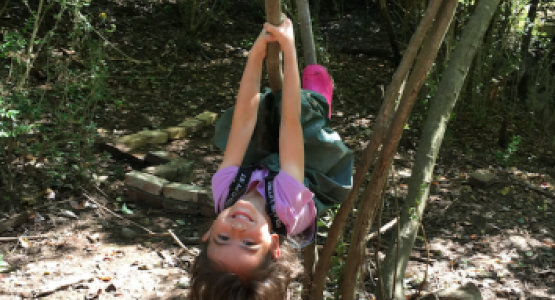
Play Is Child’s Work at Forest Classroom
Story by Valerie Morikone
With the support of its school board and church family, Mountain View Conference's Parkersburg Academy has made a bold move in their school program this year. They are offering a non-conventional kindergarten through second-grade education called “Forest Classroom”—a classroom in the woods with no walls or artificial lights.
Under the leadership of principal/teacher Monica Zill, who implemented this program, Julie Henson teaches this classroom out in nature.
The Forest Classroom offers students an opportunity to be children, to play, explore and take risks. Being outdoors in the richness of God’s nature offers support for health, emotional, physical, social and cognitive development that an indoor environment cannot reach, says Henson.
 In the morning, students spend two to four hours in the forest—rain or shine. In their surroundings, the children get fresh air and exercise and build core strength, gross and fine motor skills, stronger immunity and sensory development. They also learn life skills, such as perseverance, self-efficacy, resilience, social skills, leadership and communication skills. The students spend their afternoons indoors for more structured learning, such as reading, art, music, cooking and sewing.
In the morning, students spend two to four hours in the forest—rain or shine. In their surroundings, the children get fresh air and exercise and build core strength, gross and fine motor skills, stronger immunity and sensory development. They also learn life skills, such as perseverance, self-efficacy, resilience, social skills, leadership and communication skills. The students spend their afternoons indoors for more structured learning, such as reading, art, music, cooking and sewing.
Henson grew up in Takoma Park, Md., during the 1960s. When her mother would come home from work, she would say to Henson and her brother, “It’s too nice outside for you kids to be indoors.” The siblings would change their clothes and play outside, regardless of the weather. Henson says she has many happy memories of running out in the rain, bundling up in the winter and playing outside for hours.
So imagine her surprise when her students stood beside her near a tree-lined creek the first two weeks of school and said, “I am bored,” and, “Teacher, there is nothing to do.” Henson repeatedly told them, “Please go play—find something to do.”
Unfortunately, her students did not know how to play, imagine or explore because they lacked the very skills they were created to have. The average American spends six to seven hours daily in front of a screen and only 30 minutes per week in unstructured, outdoor play—and her students were no exception.
Henson had her work cut out but was determined to challenge her students’ minds to learn how to play outside.
Today, the Forest Classroom is full of happy sounds of children playing and asking questions such as, “Teacher, do you think we will find treasure if we dig far enough, and if so, may we keep it?” shares Henson. She adds that the forest is full of happy wonderment with children collaborating together to make an arched window for a pizza oven; creating a water pipe and experiencing erosion firsthand; and understanding the pendulum effect by swinging on a vine out across the creek are just a few things they are learning without fear of failure or pressure. There is also “sit-time” for them to listen, observe and experience the woods in its stillness, yet endless sounds.
Ellen White counsels, “The little children should come especially close to nature. ... Teach them to see the wisdom and love of God in His created works; and as their hearts swell with joy and grateful love, let them join the birds in their songs of praise” (Child Guidance, p. 48).
Research reveals that children learn best while interacting with objects in their environment. What better environment for them to play and learn in than God’s nature?

Add new comment